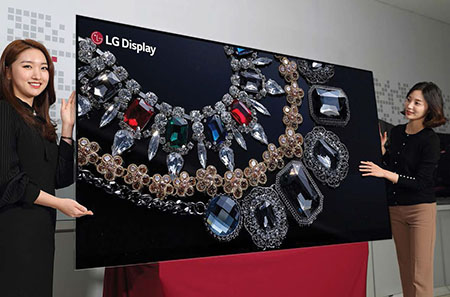Ramp Up the Processing for UHD Post
Ultra high-definition (UHD) displays are everywhere, but UHD content, at least in this country, is limited to streaming sources such as Netflix, Amazon and other online services. And since the current bandwidth allocated to U. S. over-the-air broadcasters is not sufficient to carry a UHD signal it’s driving them crazy. Although the public is still unaware, that’s leading to the ATSC 3.0 proposition of asking everyone to please purchase completely new home entertainment equipment to accommodate OTA broadcasters’ future business model.

LG’s 88-inch 8K TV was on display at CES 2018.
Of course, UHD’s 3840x2160 pixel resolution is actually the video derivative of digital cinema’s 4K (4096x2160). But instead of being a production standard like the Digital Cinema Initiative’s 4K, supported by SMPTE and ISO, UHD is more of a display standard first proclaimed by the Consumer Electronics Association (CEA) in October 2012 for 16:9 images that had at least one digital input with a native video pixel count of 3840x2160.
Then in January 2016, an industry consortium called the UHD Alliance released the “Ultra HD Premium” specification, which required greater bit depth, color gamut, high dynamic range imaging (HDRI) and rendering (HDRR) required for Ultra HD (UHDTV) content and displays to carry the Ultra HD Premium logo.
But, nevertheless, retailers still often call them “4K” sets. Why confuse the situation with clarity?
A CONUNDRUM
This odyssey has been simplified by necessity to make the point that although UHD displays are everywhere, UHD post for broadcast is still a conundrum. It makes just about as much sense as the fact that all of us drive cars that can easily exceed 100 mph, but there isn’t a mile of public roads where that would be legal. And yet, Detroit would be unable to sell a single car without that capability.

Atsushi (Alex) Kataoka
So since post-production pros are inherently the problem solvers of the broadcast industry, I welcomed the chance to speak with Atsushi (Alex) Kataoka, product manager for Grass Valley, about what we need to look forward to when getting ready for UHD post.
“First of all, UHD is all progressive,” Kataoka began. “Even in Japan, most high-definition post is still interlaced. We don’t see much 1080p over here. Only in China do we see a lot of HD progressive.”
Most people remember the original rationale for the implementation of interlaced video was to save bandwidth or storage, but Kataoka felt pretty certain if that ever became an issue producers would rather resort to 4K/30 fps (or 4K/25 overseas) if needed.
Although even Grass Valley could not find any major post houses specializing in UHD work in the United States, Kataoka assured that their EDIUS NLE could easily handle its resolution today.
But the color depth is a different question. True UHD requires 10-bit video with the High Efficiency Video Coding (HEVC) codec, also known as H.265 and MPEG-H Part 2, delivering a maximum rate of 340 Mbps to conform to UHD’s new Rec. 2020 color space that expands upon HD’s Rec. 709 slice of the visible spectrum.
You are also going to need a lot more computing horsepower. Kataoka envisions editing workstations with dual eight or 10-core Xeon CPUs working with fast RAID storage to handle the UHD I/O.
If you are wondering how high is up, rest assured that Kataoka tells us at last November’s Inter BEE in Tokyo, Grass Valley conducted a public demo with Sharp posting 8K video. Sharp rolled out an 8K, 60p camcorder at its National Dealer’s Meeting in Phoenix and Grass Valley has announced a special 8K version of EDIUS to cut it.
Not to be left behind, at this month’s CES in Las Vegas no less than four display manufacturers were scheduled to present 8K TVs in the Brobdingnagian 88-inch size and above, and last summer Japan’s NHK (who calls their version of 8K, “Super Hi-Vision’) announced the launch of satellite broadcasts in 8K and plans to broadcast the 2020 Olympics in 8K.
All of this flies in the face of the well-accepted “Lechner Distance” devised by famed researcher Bernard J. Lechner who calculated the optimal viewing between a viewer and the screen for different resolutions based on human visual acuity. He determined 5.5 feet produces the best viewing for a 42-inch 1080p image. Yet the average American sits 9 feet from the screen, which should require a 69-inch HD display. How will they get any perceived benefit from an 8K, 90-inch TV?
That’s as querulous as asking how you’re going to get it through the front door. But as stated at the beginning of this piece, this industry is not exactly running on logic.
A PRIVILEGE AND A PLEASURE
I feel it’s kind of fitting that this will be my last column for TV Technology magazine. During the last 32 years, I’ve had the privilege of reflecting on this industry in these “Focus on Editing” pages from the days of U-matic cassettes to our current hubris of 8K.
As a working editor, I’ve had the pleasure of interviewing Emmy Award-winning editors, leading NLE manufacturers and startups working on the leading edge of technology. With your help, I have somewhat whimsically identified the greatest edit of the 20th century (the bone-to-spaceship cut in “2001: A Space Odyssey”), and looked at how our craft has evolved from the silent era of cinema through the HD revolution including yesterday’s 3D and tomorrow’s evolving visual grammar of VR.
Above all, it has been the goal of this column to help define what the role of an editor is, and I stand by the credo from three decades ago that, “An editor is a creative artist who takes unconnected, diverse ideas and through the use of context, contrast and rhythm brings meaning out of confusion.”
It’s all based on your individual aesthetic sense, and if you know what I mean by recommending you try some mustard on a pickle, then you’ve been paying attention. Thank you. Fade out.
Jay Ankeney is a freelance editor and post-production consultant based in Los Angeles. Write him atJayAnkeney@mac.com.
Get the TV Tech Newsletter
The professional video industry's #1 source for news, trends and product and tech information. Sign up below.
